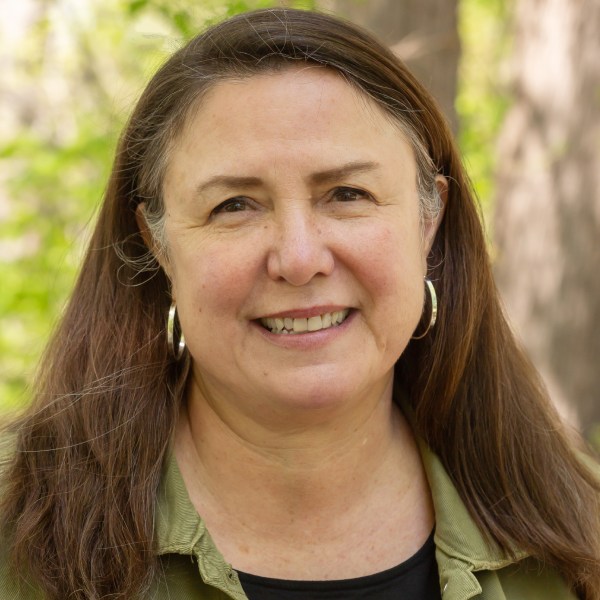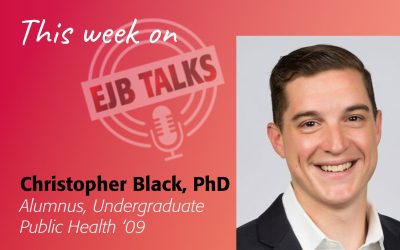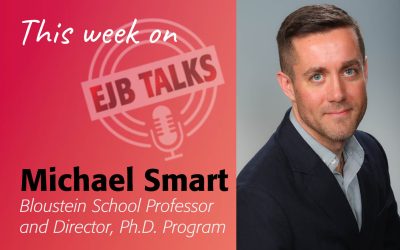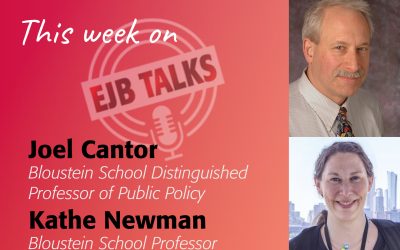This week on EJB Talks Jeanne Herb, Director of the Bloustein School’s Environmental Analysis and Communications Group (EAC), returns to talk to Stuart Shapiro. Jeanne gives the history of EAC and an overview of its vision of community-based environmental planning, its connection to health and equity, and their growing focus on the intersection of environment and people in both the natural and built environments. Jeanne highlights some of their largest projects. The exciting work she talks about includes the Megalapolitan Coastal Transformation Hub (MACH), a five-year research endeavor, in the New York City, New Jersey, Philadelphia region, with 10 other institutions besides Rutgers, led by Professor Bob Kopp, researching the factors that inform coastal climate change decisions. Other highlights of EAC’s research include a focus on local public health capacity, particularly in New Jersey, research support for the state Division of Disability Services’ Inclusive Healthy Communities program, and Jeanne’s continued commitment to teaching future leaders via her graduate course at the Bloustein School on communicating science with decision-makers.
Stuart Shapiro
Welcome to EJB Talks. I’m Stuart Shapiro, the Interim Dean of the Bloustein School, and the purpose of this podcast is to highlight the work my colleagues and our alumni in the fields of policy, planning, and health are doing to make the world the country in New Jersey a better place.
Today, we welcome Jeanne Herb back to the podcast as we speak to representatives of our research centers. Jeanne was featured on an episode, I think about 18 months ago now. It’s amazing how long we’ve been doing this. And she is the head of the Environmental Analysis and Communications Group here at the Bloustein School. Welcome back, Jeanne.
Jeanne Herb
Thanks so much for having me. Well, and congratulations on the Interim Dean-ship.
Stuart Shapiro
Congratulations, condolences. Who knows what the appropriate sentiment is! But thank you.
Let’s get started by having you remind us, since it has been 18 months, about the mission of the Environmental Analysis and Communications group and your role there.
Jeanne Herb
Thank you. Thanks so much. So the Environmental Analysis and Communications Group, which has the unfortunate acronym of EAC, which is how I will refer to it on this podcast…
Stuart Shapiro
That’s how a lot of people respond to climate change…. (((laughing)))
Jeanne Herb
Yes (((laughing)) EEEEK!
So it’s important for me to give a shout-out to Mike Greenberg, who began this research group long before I even arrived at the Bloustein School, about 11 years ago. And initially, the work grew out of Mike’s leadership and creating the National Center for Brownfields Redevelopment. At the time, Mike’s work really focused on looking at brownfields redevelopment as an opportunity to build vibrant and healthy communities. And since then, we’ve been able to build on that vision, Mike’s vision, with our leadership from Clint Andrews to move EAC more towards the direction of the community, certainly continuing community-based environmental planning, connected to health and equity, but also growing also into other areas in terms of looking at the intersection of environment and people. And that includes the natural environment, as well as the built environment.
And that allows us to also stretch out then into related issues, such as access to built and natural environmental conditions that provide equity and justice opportunities. It also allows us to look at issues associated with health and the broader environment. And it also allows us to look at opportunities to form partnerships with other folks from across the university as well as leaders here in New Jersey to better understand the role that the broader environment plays in public policy.
Stuart Shapiro
That’s great. And I love the connection between the environmental questions and the other ones like social justice and health that you mentioned, and you guys are working on a lot of fascinating projects.
Let’s start with, and Amy bet that I could not pronounce this correctly… (((laughing)))
Jeanne Herb
(((Laughing)))
Stuart Shapiro
So let me try… the Megalapolitan Coastal Transformation Hub.
Jeanne Herb
Nice!
Stuart Shapiro
I’m not going to say it again. Can you just tell me what that is?
Jeanne Herb
Yeah, so the Megalapolitan Coastal Transformation Hub, which we refer to as MACH, right? Because we really like our acronyms.
Stuart Shapiro
And you don’t want to say that word again.
Jeanne Herb
That’s right. You don’t want to say that too much. It is led by Professor Bob Kopp here at Rutgers University. It is funded by the National Science Foundation. It is a very large research endeavor. It’s a five-year research endeavor, in the New York City, New Jersey, Philadelphia region, with 10 other institutions besides Rutgers participating. The work associated with MACH is focused on examining different types of decisions and how decisions are made, and what are the factors that inform decisions with regard to coastal climate change. And that can be decisions by federal, state local agencies. That can be decisions by communities, as well as individual homeowners in terms of making their own personal decisions.
Part of what MACH is focused on is recognizing that we have many uncertainties as we plan for long-term climate futures, right? So if we’re thinking 50 years from now if we are thinking even 2050, when I turned 90, there are so many things that are uncertain; including climate futures, because the science is always evolving, including changing landforms such as coastal erosion, including even our value structure, right, who, who would have thought that I’d be working in my home most of the time now, a couple of years ago.
So what MACH is really focused on is looking at how decisions get made, what informs decisions? And then also looking at how can we better understand those processes to create climate adaptation decisions now… you know, now the next five years or so… That can be enhanced or modified as need be as we start to understand how some long term uncertainties are being made clear.
One of the things that are, I think, really innovative about MACH, is that it is a research enterprise, it is funded by the National Science Foundation. But the team associated with MACH and Professor KOPP in particular, who’s the PI, has such a strong commitment to engagement of decision-makers, stakeholders, residents, with a special focus on populations that are typically underrepresented in climate planning. So that the research agenda and the decisions really reflect the term of art in at the National Science Foundation is co-production of knowledge. But the concept that this is not a top-down, researchers tell communities what you know, what they need to be thinking or what’s important, but that we need to be doing a lot of listening.
So the way that we’ve sort of operationalized that is that rather than having the research teams from these 11 institutions out in the field, doing their research, we’re spending a lot of time right now, talking to key informants throughout the New York City, New Jersey, Philadelphia region, including community leaders, including state federal agencies, non-governmental organizations, a really wide array of decision-makers and thought leaders to better understand how to frame our questions and to identify what some of the priorities are.
Later in the spring, we’ll be doing some deeper dives in terms of engaging thought leaders and community leaders in 10 locations in the region. And then by the time we get to the later part of the spring, like mid-May, the MACH leadership will select a set of locations, which might be neighborhoods or municipalities in that region, that’ll become the focus area for MACH work over the coming four to five years.
Stuart Shapiro
And what does that engagement look like? Is it individual interviews with community leaders? Is it focus groups? Is it broad community meetings? How are you sort of getting that input?
Jeanne Herb
All of the above, and you can see the bags under my eyes right now. So we are launching probably next week, some online surveys with membership organizations that represent members that work professionally at the local level. And that includes membership organizations that represent public health officers, municipal finance professionals, floodplain managers, community planners, like Bloustein School alum, and then also nonprofit organizations that lead disaster recovery in the region. So that’s an online survey.
And then right now, we are deep into conducting one on one key informant interviews all virtual, with about 75 people in in the region. Our next step, which is in March is when we will identify a set of 10-ish locations. And again, those might be neighborhoods, those might be municipalities, they might be multiple neighborhoods, multiple municipalities, and in those places, we’ll be doing more one-on-one conversations with local stakeholders. So community leaders, mayors, professional planners, you know, faith leaders in those locations.
After that, when we choose the pilot communities where MACH will reside, over the next several years, we’ll be spending a lot of time also engaging through focus groups, and one on one conversations and I’m hoping, you know, at kitchen coffee tables, could you know, kitchen tables to talk about with residents about some of the pressure points and decision problems that they’re facing.
Stuart Shapiro
So, this fascinates me and we could probably talk a lot more about it, but I do want to get the other things. I’ve written on the nexus between doing good policy analysis and public participation because I do think that analysis is better if it’s informed by the public. And public participation is better if they know what analysts have to say. And so I can easily send you stuff on that if you’d like.
Jeanne Herb
Well, thanks. And Stu, I’ll also mention that we have a stakeholder advisory panel that is a very strong group of about two dozen people who have really informed our thinking on these issues. So much so that we’ve actually produced what we refer to as our Principles of Engagement. So this is how we’re going to engage and it provides all of us a benchmark, to be able to kind of be accountable in terms of how we’re going to engage. And I think they’re super practical. I think they have a strong… they demonstrate us operationalizing, our commitment to justice, equity, diversity, and inclusion by saying this is how we’re going to engage. For example, you know, we’re not going to be extractive, we’re going to make sure that we provide compensation for people who are advising us on some of ours, this is one example. But there are lots of other examples.
And then one other thing, one other super practical thing that’s come out of this conversation, including with leaders on our advisory panel, who lead, for example, environmental justice work, is I think what we’re going to do is we’re going to organize a mini-workshop with some of our stakeholder advisory panel members to really reflect on how do we now walk the walk to our talk? How do we take those principles of engagement and that commitment, and actually operationalize them in a very large research enterprise? And that’ll be I suspect, a public convening. And I think it’ll be really interesting.
Stuart Shapiro
That’s great stuff. And like I said, I think we could delve into even more detail. But what’s at least get one other project covered here, of the many you’re doing. How did you become involved in a project on state capacity for public health?
Jeanne Herb
Right. So that’s the funny thing about our little group is that when you really think hard about it, you can see the interconnections of some of our projects. So the one that you mentioned is one that we just finished in December, where we were looking at how much capacity, in terms of funding and support, particularly local public health has in New Jersey. And the connection to our E commission is that local public health officers nationally talk about the concept of public health 3.0, which is where public health becomes the chief strategist and communities, right. So when we think about health when the Bloustein School thinks about health, we think about health as being driven by the environment, by transportation, by housing, by economic opportunities. And what public health 3.0 is about, is looking at how do we empower local public health agencies to really lead those discussions and that kind of decision-making at a community level.
And so the connection here for us was appreciating the very limited capacity for public health, local public health here in New Jersey compared to other states. So we did some quick comparisons to other states. We talked to other states to see how they’ve been tackling this issue. We conducted an Eagleton survey of New Jerseyans to understand what do they know about local public health in New Jersey and then we’ve also talked to lots and lots and lots of public health professionals here in New Jersey and reviewed 30 years’ worth of studies and commissioned reports looking at public health in New Jersey.
And for me, what was a little bit eye-opening, quite frankly, was really coming to understand that overwhelmingly, local public health in New Jersey is funded by local property taxes, right, which no one wants to increase, and by earmarked dollars state and federal earmark dollars, right so here’s money to work on vaccines, or here’s money to work on LED or here’s money to work on education about sexually transmitted diseases, the only source of funding that was unlimited like that was unrestricted, that gave local public health some flexibility to better understand what are the needs in a community was zeroed out in 2011 and So as a result, what we see is that public health funding local public health funding in the state is under capacity and very restricted to these kinds of earmarks. So as a result, well, for example, in my world, local public health leaders want to be engaged, they want to be on the forefront of work on climate change, and health equity, they just don’t have the capacity to do it. And so it was a little bit of a roundabout way in terms of an environmental analysis and communications group. But when you really think about it, there’s a very deep connection.
Stuart Shapiro
Well, let me give you another connection and ask you about it. Because, you know, obviously, the past two years have revealed gaping challenges for our public health system, in terms of how we’ve responded to the pandemic, and part of that is not the fault of funding. It’s not the fault of the public health agencies themselves, but rather the way we react to what they tell us. And I suspect that we have the same problem with climate change. And I’m wondering if as you sort of worked on this one project, you found yourself thinking, oh, yeah, this applies to some of the work on climate change as well.
Jeanne Herb
Yes. And in fact, I’m in the fifth year of teaching a graduate course at the Bloustein School on communicating science with decision-makers, and, and I’ve learned so much in teaching the class. What’s important is that the class is about communicating science and technical issues with decision-makers per se, right? So it’s not just broad communication. It’s not just, you know, learning how to use nouns and verbs. It’s a better understanding that many of the drivers with regard to decision making, whether it’s climate change or public health, or should I get a vaccine, or should I feed my kids GMO foods are issues that are associated with our value structure? And, also issues that are associated with other pressure points in our lives? Right? I mean, can I afford to do something? Can I afford to wait to act on climate change? Or, you know, am I a renter, and I, you know, I don’t get to control these decisions.
So it’s an interesting class, in that we spend time, definitely on nuts and bolts about writing and presenting, but also in terms of starting to understand what are the drivers for decision-makers, regardless of whether those decision-makers are Governor Murphy or a funder or a local homeowner, and trying to understand the context in which we’re communicating? So some of the examples that we use in class these days are not just environment and climate change, but we talk a lot about COVID.
Stuart Shapiro
Yes, that makes total sense. All right. Before we go, let me let you highlight one other thing, whatever you choose that your centers working on.
Jeanne Herb
Okay, so I am so proud to be providing support to the state Division of Disability Services, which has launched a very bold program that’s referred to the inclusive Healthy Communities Program. So it’s a grant program that the Division of Disability Services issues to local governments, local and regional governments, nonprofit groups, and it’s all about advancing policy and systems change focused on inclusion, true inclusion of people with disabilities to advance health equity. And so we had our first round of funding about a year ago. We’re currently in the second RFP process. And we will soon, probably by early next week on the EAC website, we’ll be posting a little short video talking about some of the experiences in the first round. And when I saw the draft of it, I really kind of got a little bit teary, because some of the things that we’ve heard from the first round of grantees are that the program has been transformative in that, whether they’re doing work on community gardens, or they’re doing work on transportation access, or providing people with greater access to nature, they are now looking at their jobs through a disability lens. And they’re looking at it as a social justice issue. So I am so proud to be working with Trish Sanchez and Karen Alexander from the Voorhees Transportation Center as part of our team to be able to help facilitate this program for DDS. It’s phenomenal and for anyone who’s interested, the current RFP is posted on the EAC website as well.
Stuart Shapiro
That’s great stuff. Jeanne. Thank you again for coming on.
Jeanne Herb
Thank you!
Stuart Shapiro
Also, of course, as always, a big thank you to Amy Cobb and Karyn Olsen.
Jeanne Herbeac
Thank you, Amy.
Stuart Shapiro
We will see you next week with another talk from another of our research centers at the Bloustein School. Until then stay safe.




